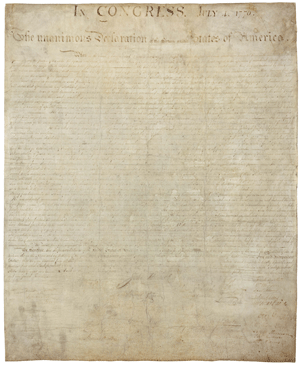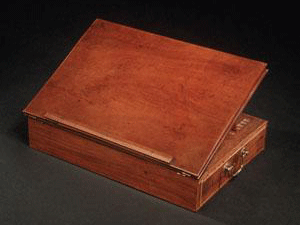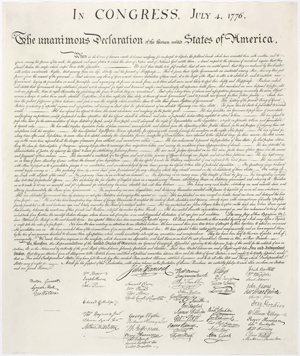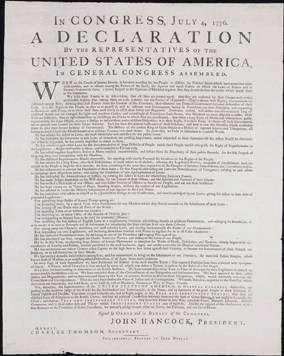|
Declaration of Independence
Answer
to Name
This Famous Antique Game - June 2013
by Mike McLeod
When in the Course of human events, it becomes necessary for one people to dissolve the political bands which have connected them with another, and to assume among the powers of the earth, the separate and equal station to which the Laws of Nature and of Nature's God entitle them, a decent respect to the opinions of mankind requires that they should declare the causes which impel them to the separation.
 Sherry Blanton and Julie Kimbrell of Old School Antique Mall in Sylva, N.C., Scott and Carolyn Brown of Memories Flea An'Tique Mall in Prattville, Ala., Teresa Bland, a collector, Ted Carlton of Utah, Sherron Lawson of Roswell, Ga., recognized the Declaration of Independence, despite its faded condition. Sherry Blanton and Julie Kimbrell of Old School Antique Mall in Sylva, N.C., Scott and Carolyn Brown of Memories Flea An'Tique Mall in Prattville, Ala., Teresa Bland, a collector, Ted Carlton of Utah, Sherron Lawson of Roswell, Ga., recognized the Declaration of Independence, despite its faded condition.
This is truly how the Declaration looks, faded and with the handprint of an unknown person in the lower left corner—even though it was restored (somewhat) in 2001. In addition to its age, its condition is due to several factors: it was written on parchment with an acidic iron gall ink; it was rolled, unrolled, and folded a multitude of times over the years; it was moved from place to place; and sometimes, it was displayed in direct sunlight. These have all led to its deterioration to the point where the names of almost all the signers are unreadable, and John Hancock’s signature is blurry.
It is believed by some that William J. Stone used a wet transfer process to make copies from the original in 1820. There is a controversy about this; other historians believe he did not use this process. If he did, a thin, wet piece of paper was pressed on the Declaration to remove some of the original ink. The wet paper was then used to etch a copper plate for making copies. If this was done, it caused much of the fading of the original.
What is known is the Declaration of Independence was damaged in 1846 when an anastatic printing process was used to make copies. An acid solution was used to dampen the Declaration, and after blotting off excess liquid, the Declaration of Independence was pressed on a zinc plate. The ink in the Declaration prevented the acid from interacting with the zinc, but the solution between the letters corroded the zinc plate, leaving a reverse copy in slight relief. The plate was then used for printing copies. However, the Declaration of Independence was much worse after the process.
An anastatic copy was purchased for $100 at a flea market in Pennsylvania many years ago by Tom Lingenfelter, a rare documents dealer. Neither he nor the seller knew exactly what it was at the time. Lingenfelter kept it for many years and then took it to Independence Hall in Philadelphia, which up to that moment had the only known anastatic copy. Lingenfelter learned he had the only known second copy in existence.
Today, we think the damage done to the Declaration of Independence is tragic. However, in the early days of the nation, the Declaration was thought of as just another government document, nothing special. At the time of its adoption by the Continental Congress, the Thirteen Colonies had already been at war with Great Britain for a year, and they weren’t sure they would win their independence. It was not until some years later that the Declaration of Independence was revered as a sacred document.
The Declaration was written by Thomas Jefferson and edited by the Committee of Five (John Adams, Benjamin Franklin, Robert Livingston, Roger Sherman and Thomas Jefferson). It was then edited again by the other delegates before the 4th of July.
|

|
The writing desk designed and used by Thomas Jefferson for writing the Declaration of Independence.
|
The Declaration was adopted—but not signed—on July 4th by the delegates from all the colonies except New York. (Its delegates did not have permission to support independence from Britain because the New York Legislature was not in session—the Revolutionary War was on in New York.) The edited and adopted version was sent to John Dunlap, a printer, the night of the 4th, and he printed 200 copies that night. Those were sent to the colonies and to George Washington.
Twenty-six copies of the Dunlap Broadside of the Declaration of Independence still exist today. These bear no signatures, just the printed name of John Hancock. Most are in the collections of museums, libraries and governments. The last was found in 2009 in the National Archives in England. (No one knows how it got there; they suppose a British warship captured an American vessel with it on board.) In 2000, Sotheby’s sold a Dunlap Broadside for $8.14 million to TV producer Norman Lear and a partner. This was the copy found in 1989 in a flea market hidden behind a frame and purchased for $4.
|

|

|
|
Stone copy
|
Dunlap Broadside
copy
|
Printed copies of the Declaration were also made in 1777 by order of Congress by Mary Katherine Goddard. Nine of these copies are still in existence.
As mentioned above and contrary to what most of us learned in school, the Declaration of Independence was not signed July 4th. The Declaration of Independence in the National Archives that is signed and considered to be the original was handwritten by Timothy Matlack, a clerk, after the Dunlap Broadside was printed. It was finally signed on August 2. (It took him some time to clearly and evenly inscribe this 1,337-word document on parchment.) By that time, the New York delegation was authorized to sign it.
Each colony’s delegates signed as a group with New Hampshire in the north going first and Georgia in the south last. Five delegates were not present on August 2, but they signed later. Two delegates chose not to sign it: John Dickinson of Pennsylvania and Robert Livingston of New York. Dickinson felt the colonies could reconcile with Great Britain. Yet, on Aug. 2nd, he was doing his duty on the battlefield fighting for independence. Livingston, one of the Council of Five, thought it was too soon for the colonies to be independent.
It was not too soon for independence then, and even though this historic document is faded and dimmed by time, by abuse, and by a lack of proper attention and care, it reminds us that it is too soon to relinquish our freedoms today.
We hold these truths to be self-evident, that all men are created equal, that they are endowed by their Creator with certain unalienable Rights, that among these are Life, Liberty and the pursuit of Happiness.
|